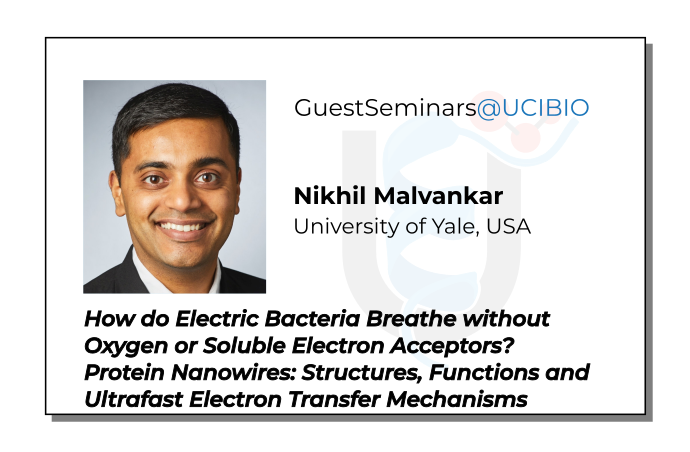
How do Electric Bacteria Breathe without Oxygen or Soluble Electron Acceptors?
Protein Nanowires: Structures, Functions and Ultrafast Electron Transfer Mechanisms
Dept. of Molecular Biophysics. & Biochemistry, Microbial Sciences Institute, University of Yale, USA
Host: Carlos Salgueiro, UCIBIO, NOVA
ZOOM link: https://ucibio.pt/l/GuestSeminars
Abstract:
Deep in the ocean or underground, where there is no oxygen, Geobacter “breathe” by projecting tiny hairlike protein filaments called "nanowires" to dispose of excess electrons resulting from the conversion of nutrients to energy, cleaning up radioactive sites. Although it is long known that Geobacter use filaments for electron transfer (Nature 2002, 2005), it was not clear what they are actually made of and why they are conductive.
Our studies have revealed a surprise: the nanowires have a core of hemes lining up to create a continuous path along which electrons travel (Cell 2019, Nature Chem.Bio 2020, Nature Micro 2023) and and can be engineered with atomic precision using recombinant DNA technology, making for remarkably versatile electronic components.
We have further found that Geobacter pili remain hidden inside the cell and serve as a piston to secrete nanowire-forming cytochromes (Nature 2021) rather than functioning as a nanowire themselves as previously thought (Current Opinion 2020).
These studies solve a longstanding mystery to explain our previous findings that these bacteria transport electrons via nanowires (Nature Nano. 2014) over 100-times their size to electron acceptors (Nature Nano. 2011) and partner cells (Science 2010) and store electrons when acceptors are absent akin to how humans use their lungs (ChemPhysChem 2012) .
Our contact-free measurements of intrinsic electron conductivity in individual protein nanowires reveals how energetics and proximity of proton acceptors modulate conductivity by 100-fold (PNAS 2021, Biochem. Journal 2021). We have also developed synthetic protein nanowires with tunable conductivity and programmable self-assembly using non-natural click chemistry functionality (Nature Comm. 2022).
In this talk I will present our efforts to identify the physical and molecular mechanism of high conductivity of microbial cytochrome nanowires. Our conducting-probe AFM measurements show one of the highest electronic conductivities ever reported in proteins (> 100 S/cm) (Nature Chem.Bio 2020). Femtosecond transient absorption spectroscopy and quantum dynamics simulations reveal ultrafast (<200 fs) electron transfer between nanowire hemes upon photoexcitation, enhancing carrier density and mobility. Photoconductive atomic force microscopy shows up to 100-fold increase in photocurrent in purified individual nanowires. Photocurrents respond rapidly (<100 ms) to the excitation and persist reversibly for hours (Nature Comm 2022). Furthermore, nanowires and biofilms show non-classical temperature dependence of conductivity with cooling accelerating electron transport by 300-fold.
Multiple computational studies have predicted that invoking quantum effects could account for the high conductivity of these nanowires (Nanotechology 2020, IEEE 2021, ACS Nano 2023). I will present our efforts to experimentally assess these computational predictions using multiple probes such as light, temperature, electric and magnetic fields. I will also discuss how our studies are helping to understand, predict and control extracellular electron transfer by nanowires used by diverse environmental microbes to capture, convert and store energy.
Short CV:
N. Malvankar received his M.S. in Physics from Indian Institute of Technology (IIT), Mumbai, and then moved to University of Massachusetts, Amherst for his Ph.D. training in Biophysics, where he developed new measurements methods that revealed for the first time electron conductivity and storage capacity in microbial biofilms due to bacterial cytochrome proteins. His postdoctoral work with Derek Lovley in the Microbiology Department demonstrated that the conductivity is essential for bacterial respiration and communication.
In 2015, N. Malvankar established his independent group at Yale and has been leading an interdisciplinary team to develop and apply novel technologies to define the mechanisms by which microbes interact with and manipulate their environment, with the ultimate goal of engineering these interactions to control microbial pathophysiology and ecology. He has received the Blavatnik Award for Innovation and Camille Dreyfus Teacher-Scholar Award in 2021, NSF CAREER Award in 2018, NIH Director’s New Innovator Award and Hartwell Foundation Individual Biomedical Research Award in 2017, Charles H. Hood Foundation Child Health Research Award in 2016 and the Burroughs Wellcome Fund Career Award at the Scientific Interface in 2014.
